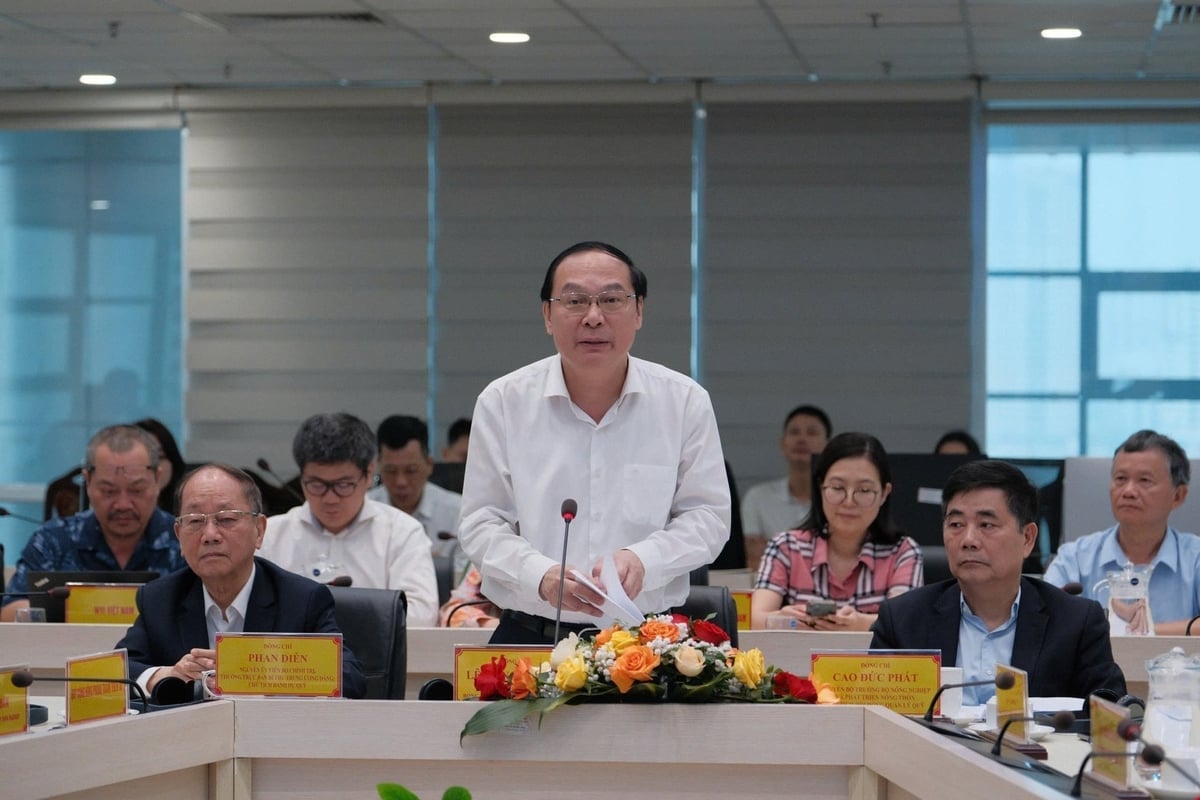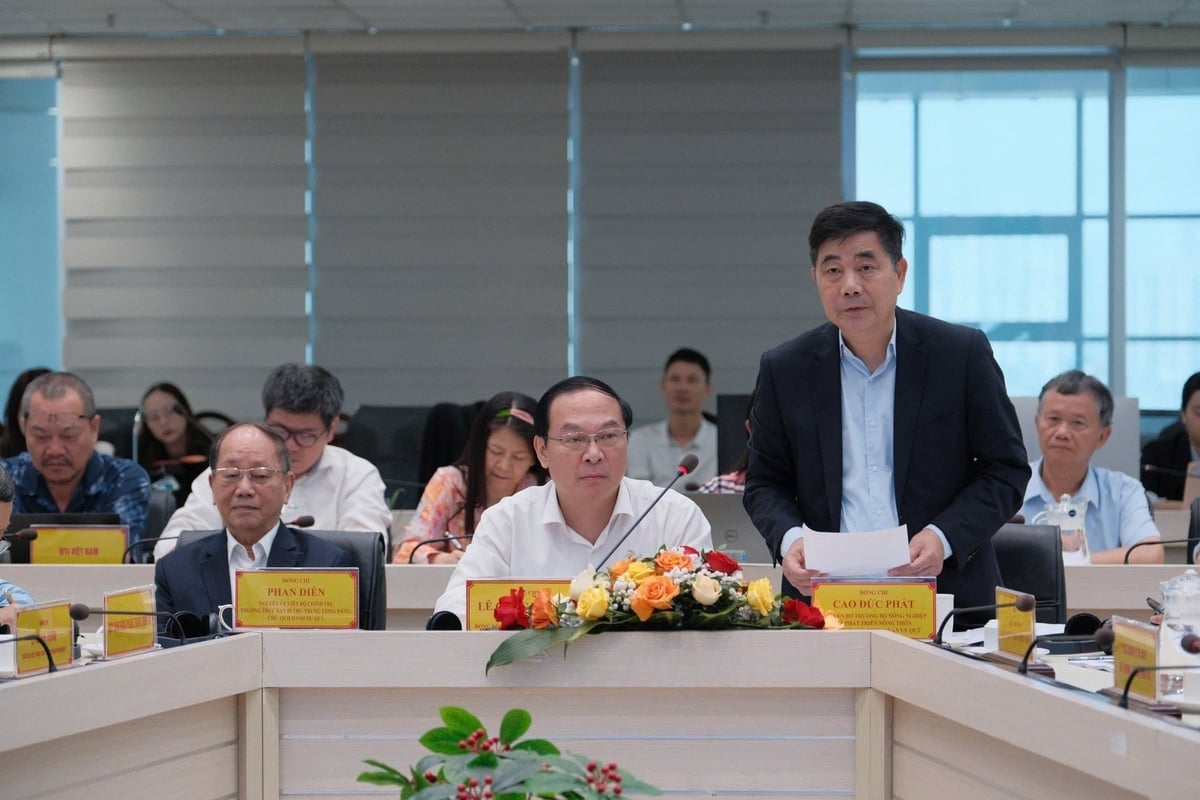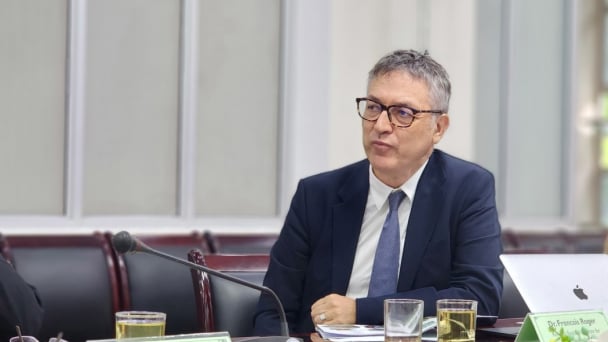April 28, 2025 | 21:02 GMT +7
April 28, 2025 | 21:02 GMT +7
Hotline: 0913.378.918
April 28, 2025 | 21:02 GMT +7
Hotline: 0913.378.918
The Vietnam Agriculture and Nature Newspaper (VAN News) and the Department of Meteorology and Hydrology collaborated to organize the event.
During the seminar, Deputy Minister of Agriculture and Environment Le Cong Thanh emphasized the need for decisive and coordinated action to prevent flash floods and landslides, as recent disaster patterns have shown a distinct upward trend.
Prompt community-level actions and early warnings are essential components in mitigating the effects of natural disasters, according to the Deputy Minister.

Deputy Minister of Agriculture and Environment Le Cong Thanh speaks at the seminar. Photo: Quynh Chi.
Nevertheless, he also noted that there is still a substantial challenge in providing comprehensive warnings down to communes, villages, and population clusters, despite the advancements in forecasting technology. This is especially true in remote regions, where residents face significant obstacles in disaster preparedness and response, including limited access to information and the absence of direct warning systems.
In this context, Deputy Minister Le Cong Thanh commended the Community Disaster Prevention Fund for its initiatives and endeavors. He stated that the Fund's activities are not only technically supportive but also act as a successful bridge between three critical stakeholders: the government, scientists, and local communities. Therefore, they contribute to the development of a long-term, sustainable, and effective social model for disaster prevention.
The Deputy Minister also emphasized the importance of maintaining the social partnership model that the Fund has promoted, as it creates an environment that enables the mobilization of resources beyond the state budget to participate in community programs designed to ensure the protection of individuals.
Deputy Minister Le Cong Thanh emphasized the importance of establishing distinct thresholds for disaster warnings to facilitate proactive community responses. He emphasized that the information provided should be accurate, timely, comprehensible, and tailored to the local response capabilities.
Furthermore, he recommended establishing procedures for local evacuation and on-site assistance, as well as developing mechanisms for sharing warning data among various administrative levels, along with leveraging local experiences. In addition, he suggested for the implementation of contemporary technologies to provide early warnings of flash floods and landslides, as well as the promotion of social engagement in the establishment of automatic warning stations in high-risk communities.

Dr. Cao Duc Phat, Chairman of the Community Fund for Natural Disaster Prevention, shared about the positive changes since the implementation of Decision 1262. Photo: Linh Linh.
He confirmed that the Ministry of Agriculture and Environment would continue in its efforts to expand these models by refining policies, innovating technology, and working closely with stakeholders to transform initiatives into reality.
Chairman of the Community Disaster Prevention Fund, Dr. Cao Duc Phat, observed that the implementation of Decision 1262 on early warnings for landslides and flash flooding had resulted in positive changes, thereby enhancing disaster monitoring and warning in mountainous and midland regions. The Fund has secured funding to install 903 automatic rain-gauge stations and 24 automatic warning structures as a result of donor support.
He suggested three priority directions: creating organizational mechanisms and local response forces; integrating risk maps and warning information into local online systems; and identifying appropriate technologies for effective monitoring and forecasting.
He emphasized the importance of rapid information processing and swift action on the ground for AI and modern technology to be beneficial.
Deputy Head of the Department of Disaster Response and Recovery under the Directorate of Water Resources and Disaster Prevention, Nguyen Xuan Tung, recognized substantial progress in forecasting and warning initiatives. Currently, the National Centre for Hydro-Meteorological Forecasting issues warnings for excessive rain in mountainous regions. It has implemented an online warning system that reaches the commune level through a dedicated website (luquetsatlo.nchmf.gov.vn). The installation of approximately 1,500 automatic rain gauge stations in various locations has facilitated the provision of timely warnings and evacuations. Numerous provinces and cities have implemented various infrastructure projects, relocated residents from high-risk areas, and developed disaster prevention plans to mitigate flash floods and landslides.

During the 2015-2024 period, flash floods and landslides in the northern and central mountainous regions caused serious damage, killing or leaving missing an average of 79 people each year, accounting for 36% of the total number of deaths due to natural disasters. Photo: VGP.
However, there are still significant obstacles and deficiencies. Rugged terrain, steep slopes, short-duration heavy rainfall, and complex geological conditions complicate pinpointing precise disaster locations and timings. The current infrastructure for disaster prevention is both ineffective and insufficient; numerous residential areas in high-risk areas have not been promptly relocated. In many regions, equipment is obsolete, and monitoring systems are not widely available. Therefore, forecasts and warnings continue to be inadequately detailed and unreliable. Risk maps are overly broad in scope and inadequately detailed at the village level, which complicates prevention and response activities.
Additionally, there is a lack of community awareness and response skills, particularly in remote regions. Community-level emergency response teams frequently encounter deficiencies in human resources, equipment, and specialized training, while residents frequently lack essential evacuation and emergency response skills. Climate change has altered conventional rain-flood patterns, resulting in uncertainty for conventional forecasting models. Particularly, deforestation, mineral extraction, and unauthorized construction on hillsides and riverbanks have contributed to an increase in disaster risks, which are a result of unsustainable socio-economic development. In the meantime, relocation initiatives continue to face obstacles due to funding shortages, limited land availability, and the challenge of ensuring sustainable livelihoods, particularly in the northern mountainous regions.
The Department representative suggested a variety of solutions in light of this context. Institutional measures necessitate the reinforcement of legal frameworks, increased investment in disaster prevention infrastructure and warning systems, and the regulation of urban planning and resettlement in conjunction with livelihood sustainability. On the technological front, it is recommended that the capacity for short-term heavy rainfall forecasting be improved, village-level risk maps be developed, and rain-sensing systems and early warning devices be deployed in conjunction with digital technologies and AI.
Clear and accessible communication, training for vulnerable groups, and the provision of local response teams with the requisite resources and instruments are essential for community-level improvements. Lastly, it is imperative to improve international cooperation, encourage private sector contributions through appropriate technological solutions, and effectively mobilize financial resources, such as government budgets, disaster funds, and national target programs.
Translated by Linh Linh

(VAN) The focus is on assessing the potential of coastal protection solutions, particularly hybrid nature-based solutions, aimed at promoting the sustainable development of the Mekong Delta coastal region.

(VAN) FAO's representiative believes that media engagement will help build strategic partnerships, scale-up collective multi-stakeholder efforts, and help Vietnam achieve the 2030 Agenda, and ultimately maximize the positive impacts for beneficiaries that FAO supports.

(VAN) Coastal seawater in the Mekong Delta is considered to be of good quality and could be studied for use in aquaculture, with wastewater potentially reused for forest planting.

(VAN) By keeping communities up-to-date, VAN News fosters inclusive dialogue, brings visibility to local knowledge and initiatives, and creates a sense of shared ownership over the transition across multiple levels of stakeholders.

(VAN) On the occasion of the first issue of Vietnam Agriculture and Nature News following its merger, Deputy Minister of Agriculture and Environment Phung Duc Tien shared his view.

(VAN) The collaboration among press, science, and policy is creating favorable conditions for the adoption of nature-based agricultural solutions and development of sustainable livelihoods.